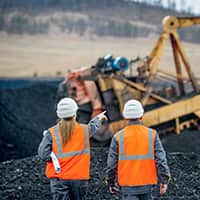Get Your MSHA Mining Safety Certification
Written by Mary Salatino

Mining operations are vital for various industries, providing essential resources that fuel economic growth. However, with the inherent risks associated with mining, ensuring the well-being of workers is very important.
The Mine Safety and Health Administration (MSHA), a regulatory agency within the United States Department of Labor, plays a crucial role in regulating and promoting safety standards within the mining industry. This article explores industry hazards, training programs and more to help you obtain MSHA certification.
MSHA Training
MSHA offers various programs to ensure that individuals working in the mining industry have the skills to navigate the specific hazards associated with their roles. These programs cover a range of topics and are designed to address the diverse needs of miners, supervisors, contractors and other personnel.
Here are some types of MSHA safety training programs:
- New Miner Training (Part 46 and Part 48):
- Part 46: This program is designed for new miners working in non-metal mines, such as sand and gravel operations. It covers basic protective principles, hazard recognition, terminology, emergency procedures and an introduction to MSHA regulations.
- Part 48: Applicable to metal and non-metal mines, as well as surface coal mines, Part 48 new miner training is similar to Part 46 training but is tailored to the specific hazards associated with these types of mining operations.
- Task-Specific Training: Task-specific training is for individuals with roles that involve specialized activities within mining operations. This can include equipment operators, blasters, electricians and other personnel with unique responsibilities. Education is tailored to address the specific hazards associated with these tasks.
- Surface Miner Training: Surface miner programs focus on the unique hazards present in surface mining operations. This includes safety measures related to stockpiles, highwalls and other surface-specific features.
- Underground Miner Training: Underground miner training is designed for individuals working in underground mining operations. It covers hazards associated with confined spaces, ventilation, ground control and other aspects specific to working below the surface.
- Supervisor Training: Supervisors in mining operations complete specialized programs to equip them with the leadership and managerial skills required to oversee safety practices and enforce regulations.
- Annual Refresher Training: Both Part 46 and Part 48 require annual refresher training to keep experienced miners updated on industry changes, regulations and emerging concerns. This ongoing education helps maintain a high level of safety awareness.
Individuals must maintain thorough documentation of their education during the certification process. This includes certificates of completion, transcripts and records of any additional task-specific training. Proper documentation is evidence of compliance during regulatory inspections.
Employers must keep training records for all employees. This ensures that each worker possesses the necessary certifications for their role. This documentation is critical for demonstrating a commitment to safety and adherence to MSHA regulations.
Mining Industry Hazards
The nature of mining work presents many hazards that demand vigilance, safety measures and a commitment to the well-being of those working in this challenging environment. Be aware of these key mining industry hazards:
Cave-ins:
One of the most significant hazards in underground mining is the risk of cave-ins. The extraction of minerals often involves creating voids and tunnels beneath the Earth’s surface. Without proper structural support, these tunnels can collapse and threaten miners.
Rigorous engineering measures and constant monitoring are essential to prevent cave-ins and protect the integrity of underground workspaces.
Explosions:
The potential for explosions is a significant concern in both underground and surface mining operations. Methane gas, coal dust and other flammable substances can accumulate in confined spaces, creating an explosive atmosphere. Sparks from equipment or electrical sources can trigger catastrophic explosions.
Stringent safety protocols, proper ventilation systems and the use of intrinsically safe equipment are crucial in mitigating the risk of explosions.
Exposure to Harmful Substances:
Miners often face exposure to harmful substances, including dust, fumes and toxic chemicals. Prolonged exposure can result in respiratory issues, skin conditions and long-term health effects.
Implementing effective ventilation systems, providing personal protective equipment (PPE) and adhering to strict hygiene practices are essential to minimize the health risks associated with exposure to harmful substances.
Noise and Vibration:
Mining equipment and machinery generate high levels of noise and vibration, contributing to potential health hazards for workers. Prolonged exposure to such conditions can lead to hearing loss and musculoskeletal disorders.
Implementing noise control measures, conducting regular equipment maintenance and providing suitable PPE are critical to protecting miners.
Equipment-Related Risks:
Mining involves the use of heavy machinery and equipment, which poses its own set of risks. Accidents such as equipment collisions, falls and entanglements can result in severe injuries or fatalities.
Regular equipment inspections, training and adherence to safety guidelines help prevent accidents related to the operation and maintenance of mining machinery.
Safety is a top priority in the mining industry. Highlighting preventative measures, participating in training and fostering collaboration can pave the way for a secure future in mining. Recognizing risks, implementing effective measures and embracing innovation are key to shaping a sustainable industry.
